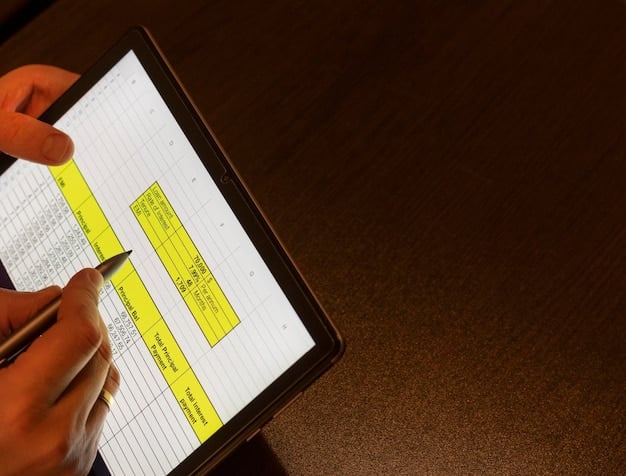Maximize Your Research Tax Credit in 2025: Don’t Miss This!

Claiming the credit for increasing research activities in 2025 can significantly reduce your tax liability and boost your innovation efforts, provided you understand the eligibility criteria and documentation requirements.
Don’t leave money on the table! Understanding and claiming the credit for increasing research activities in 2025 can be a game-changer for businesses investing in innovation. Let’s explore how to make the most of this valuable tax incentive.
Understanding the Research and Development (R&D) Tax Credit
The Research and Development (R&D) tax credit, also known as the research activities credit, is designed to incentivize companies to invest in innovation and technological advancement within the United States. It’s a valuable tool for businesses of all sizes, offering a direct reduction in their tax liability based on qualified research expenses (QREs).
This credit isn’t just for big corporations with sprawling research labs. Small and medium-sized businesses (SMBs) often qualify, and many are unaware of the potential benefits. Let’s delve into the specifics of what constitutes qualified research and how you can determine if your company is eligible.
Defining Qualified Research
Qualified research isn’t just about inventing the next groundbreaking technology. It encompasses a broader range of activities that involve experimentation and the pursuit of new knowledge. Key elements include:
- Discovering New Technological Knowledge: The research must aim to discover new information that advances technological or scientific understanding.
- Designed to Eliminate Uncertainty: The primary goal of the research should be to uncover information to resolve uncertainty concerning the development or improvement of a business component.
- Technological in Nature: The research process must fundamentally rely on principles of physical or biological sciences, engineering, or computer science.
- Substantially All Activities Constitute Elements of a Process of Experimentation: Activities related to the research must constitute elements of a process of experimentation for a qualified purpose.
Remember, it’s not just about success; it’s about the process. Even failed experiments can contribute to the QREs.
Eligible Expenses for the R&D Credit
Identifying eligible expenses is a critical step in claiming the R&D tax credit. QREs typically comprise the following:
- Wages: Salaries paid to employees who perform, directly supervise, or directly support qualified research activities.
- Supplies: Tangible property that is used in the conduct of qualified research.
- Contract Research Expenses: Payments made to third parties for performing qualified research on behalf of the taxpayer.
- Computer Leasing Costs: Expenses related to leasing computers used in qualified research.
Careful tracking and documentation are essential for substantiating these expenses. This includes time tracking, project records, and invoices.

Understanding what qualifies as research and which expenses are eligible is the first step in leveraging the R&D tax credit. The next sections will guide you through the practical steps to ensure you’re ready to claim your credit in 2025.
Steps to Prepare for Claiming the Credit in 2025
Claiming the credit for increasing research activities requires careful planning and execution. The following steps can help you effectively prepare for your 2025 filing.
Proper documentation is paramount, and a proactive approach will save you time and potential headaches down the line. Let’s explore these steps in more detail.
Documenting Qualified Research Activities
Thorough documentation is the foundation of a successful R&D tax credit claim. This documentation serves as evidence to support your claim and stands up to scrutiny during an audit. Key documentation includes:
- Detailed Project Records: Keep comprehensive records of all research projects, including project goals, methodologies, experimentation processes, and outcomes.
- Time Tracking: Accurate time tracking is essential for allocating wages to qualified research activities. Employees involved in research should maintain detailed records of the time spent on qualifying tasks.
- Expense Tracking: Preserve all invoices, receipts, and other relevant documentation for supplies, contract research expenses, and computer leasing costs.
- Laboratory Notebooks: Use laboratory notebooks to document experiments, procedures, and findings thoroughly.
Digital tools and software can streamline the documentation process, ensuring that all relevant information is captured and readily accessible. Consider adopting these technologies to improve accuracy and efficiency.
Calculating Qualified Research Expenses (QREs)
Calculating QREs accurately is fundamental to maximizing your R&D tax credit benefit. Understanding the nuances of eligible expenses and applying the correct calculation methods are essential. Here’s a breakdown of the process:
In addition to wages, supplies, and contract research, remember to account for expenses like computer leasing costs, provided they are directly related to qualified research. Document all calculations thoroughly, and seek professional guidance if necessary to ensure accuracy and compliance.
Consulting with Tax Professionals
Navigating the complexities of the R&D tax credit can be challenging, and seeking the expertise of a qualified tax professional can be invaluable. Tax professionals can provide several key benefits:
Furthermore, maintaining an open line of communication with your tax advisor throughout the year can help you stay on top of any changes in tax regulations or interpretations. This proactive approach enhances your prospects of effectively claiming the R&D tax credit in 2025.

By taking these steps, you’ll be well-prepared to claim your research tax credit in 2025. Investing the time and effort upfront can yield significant financial rewards, so don’t overlook these crucial steps.
Common Mistakes to Avoid When Claiming the R&D Credit
Claiming the R&D tax credit can present numerous challenges and complexities. Being aware of common pitfalls and errors can prevent costly mistakes and ensure compliance with IRS regulations.
Paying close attention to these potential pitfalls will significantly improve your chances of successfully claiming the R&D tax credit and maximizing your return.
Overlooking Qualified Activities
One of the most frequent errors in claiming the R&D tax credit is overlooking activities that actually qualify for the credit. Companies may underestimate the scope of what constitutes qualified research, assuming that only breakthrough innovations are eligible.
Remember that qualified research encompasses efforts to improve existing products or processes, develop new technologies, or enhance software capabilities. Take a broad view of your company’s activities and thoroughly assess whether any projects meet the criteria for qualified research.
Insufficient Documentation
Inadequate documentation is another common mistake that can jeopardize an R&D tax credit claim. Without proper documentation, it’s challenging to substantiate your expenses and defend your claim during an audit.
- Project Records: Project records include details of your research projects, goals, methodologies, experimentation processes, and outcomes.
- Tracking Hours: Employee time tracking is critical for allocating wages to eligible research activities. Accurate data supports the deduction of wage expenses.
- Detailed Expense Reports: Reconciling the cost of materials and other research-related expenses will increase the strength of your claim.
Maintain meticulous records of all qualified research activities and corresponding expenses. Use digital tools and software to streamline the documentation process and ensure that all relevant information is captured.
Misclassifying Expenses
Misclassifying expenses can lead to inaccurate calculations of the R&D tax credit. Ensure that expenses are properly classified as QREs and that any non-qualified expenses are excluded from your calculation.
Understanding the nuances of eligible expenses and applying the correct definitions and interpretations are essential. Seek professional advice if you’re unsure about the proper classification of expenses.
Being mindful of these common mistakes and taking proactive measures to avoid them will significantly enhance your prospects of successfully claiming the R&D tax credit and maximizing your financial benefit.
Maximizing the Benefits of the R&D Credit
Successfully claiming the R&D tax credit can provide significant financial benefits to your company. Maximizing these benefits requires a strategic approach that goes beyond simply identifying qualified research activities and claiming eligible expenses.
Implementing these strategies can help your company fully leverage the advantages of the R&D tax credit and fuel ongoing innovation and growth.
Strategic Planning for R&D Activities
Strategic planning ensures that your R&D efforts are aligned with your organization’s overall goals to achieve maximum benefit when claiming the credit. Consider the following when planning for your R&D activities.
- Innovation goals: The primary goal should be to develop new tech and innovate wherever possible.
- Allocate resources to allow employees to focus on R&D without being overburdened.
- Budget funds to R&D activities based on strategic planning.
Regularly review and update your R&D strategy to ensure that it remains aligned with your business objectives and market trends. This proactive approach will not only maximize your R&D tax credit benefit but also drive innovation and growth throughout your organization.
Tracking R&D Expenses Throughout the Year
Efficiently tracking your qualified research expenses will allow you to compile relevant costs when it comes time to deduct. There are a few things to note here.
- Categorize R&D Expenses accurately to reflect accurate deductions.
- Use software to easily track and reconcile R&D deductions.
- Set up automatic systems to track costs.
Regularly Reviewing and Updating Documentation
Ensure that all documentation practices are updated and accurate to reflect changes in processes or expenses. Consider the following tips to help you out:
By adopting these practices, you can effectively maximize the benefits of the R&D tax credit while remaining compliant with IRS regulations.
The Future of the R&D Tax Credit
The R&D tax credit has a long and evolving history, with changes in legislation and interpretations shaping its scope and applicability. Understanding the current landscape and anticipating future trends are essential for companies looking to leverage this valuable incentive.
As the business and regulatory environment continues to evolve, companies that stay informed and adapt their strategies accordingly will be best positioned to maximize the benefits of the R&D tax credit and drive innovation and growth.
Legislation and Policy Updates
Keeping abreast of legislative developments is crucial for remaining in compliance with changing rules. Here are a few things to consider.
- Stay in touch with tax professionals.
- Track proposed tax law changes.
- Read IRS memos and updates.
Technological Advancements and R&D
It’s important to know how new technology may impact the tax credit. Consider the following:
- Use innovative technologies to improve tracking.
- Be wary of digital transformation that pushes R&D activities far into the future.
- Balance technological upgrades and cost-cutting methods appropriately.
Industry Trends and Innovations
The business world is an ever-changing environment. It is important to keep up with industry news.
Regularly monitor industry publications, attend conferences and industry events, and engage with thought leaders to stay abreast of the latest trends and developments. This proactive approach will enable your company to identify new opportunities for innovation and maximize the benefits of the R&D tax credit.
| Key Point | Brief Description |
|---|---|
| 🔑 Qualified Activities | Encompasses efforts to improve existing products, processes, or software development. |
| 🧾 Documentation | Maintain detailed records of projects, hours, and expenses for audit defense. |
| ✅ Strategic Planning | Set innovation goals and allocate sufficient resources for R&D activities. |
| 🧑💼 Tax Professional | Consult tax experts to navigate complexities and ensure maximum credit benefit. |
FAQ
▼
Qualified research aims to discover new information, eliminate uncertainty, and relies on principles of science or engineering, including experimentation purposes.
▼
Eligible expenses include wages paid to research employees, expenses on supplies and lease of computers for research activities and payments to third parties.
▼
Effective documentation involves maintaining detailed project records, tracking employee time spent on research, keeping expense reports, and using digital software.
▼
Mistakes to avoid include overlooking qualified activities, insufficient documentation, misclassifying expenses, and not consulting with professionals.
▼
To maximize your credit, strategically plan R&D, track expenses year-round, review and update documenation, and stay updated with legislation and policy.
Conclusion
Navigating the **credit for increasing research activities in 2025** requires diligence, thorough documentation, and staying informed about legislative updates. By understanding the eligibility criteria, avoiding common mistakes, and strategically planning your R&D activities, you can unlock significant tax savings and drive innovation within your company. Remember to consult with tax professionals to ensure compliance and maximize your credit benefit.